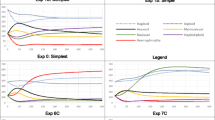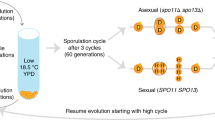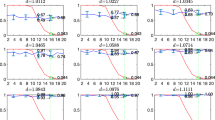Abstract
Using computer simulations I studied the simultaneous effect of variable environments, mutation rates, ploidy, number of loci subject to evolution and random and assortative mating on various reproductive systems. The simulations showed that mutants for sex and recombination are evolutionarily stable, displacing alleles for monosexuality in diploid populations mating assortatively under variable selection pressure. Assortative mating reduced excessive allelic variance induced by recombination and sex, especially among diploids. Results suggest a novel adaptive value for sex and recombination. They show that the adaptive value of diploidy and that of the segregation of sexes is different to that of sex and recombination. The results suggest that the emergence of sex had to be preceded by the emergence of diploid monosexual organisms and provide an explanation for the emergence and maintenance of sex among diploids and for the scarcity of sex among haploid organisms.
Similar content being viewed by others
REFERENCES
Bell, G. and J. Maynard Smith (1987). Short-term selection for recombination among mutually antagonistic species. Nature 328: 66–68.
Davis, C.H. (1995). The effect of assortative mating and environmental variation on selection for sexual reproduction. Evolutionary Theory 11: 51–53.
Ebert, D. and W.D. Hamilton (1996). Sex against virulence: The coevolution of parasitic diseases. Trends in Ecology and Evolution 11: 79–82.
Haig, D. and C.T. Bergstrom, (1995). Multiple mating, sperm competition and meiotic drive. Journal of Evolutionary Biology 8: 265–282.
Hamilton, W.D., R. Axelrod and R. Tanese (1990). Sexual reproduction as an adaptation to resist parasites (A review). Proceedings of the National Academy of Sciences (USA) 87: 3566–3573.
Heisler, I.L. (1984). A quantitative genetic model for the origin of mating preferences. Evolution 36: 1283.
Hill, W.G. and A. Robertson (1966). The effect of linkage on limits to artificial selection. Genetic Research 8: 269–294.
Howard, R.S. and C.M. Lively (1994). Parasitism, mutation accumulation and the maintenance of sex. Nature 367: 554–556.
Hurst, L.D. and J.R. Peck (1996). Recent advances in the understanding of the evolution and maintenance of sex. Trends in Ecology and Evolution 11: 46–52.
Jaffe, K. (1996). The dynamics of the evolution of sex: Why the sexes are, in fact, always two? Interciencia 21: 259–267 and errata in 22: 48.
Jaffe, K. (1998). Sex, mate selection and evolution. In: Lecture Notes in Computer Science 1447: Evolutionary Programming VII, Springer Verlag, V.W. Porto, N. Saravanan, D. Waagen and A.E. Eiben (Eds.), pp. 483–492.
Jaffe, K. (1999). On the adaptive value of some mate selection strategies. Acta Biotheoretica 47(1): 29–40.
Jaffe, K., S. Issa, E. Daniels and D. Haile (1997). Dynamics of the emergence of genetic resistance to pesticides among asexual and sexual organisms. Journal of Theoretical Biology 188: 289–299.
Judson, O.P. and B.B. Normak (1996). Ancient asexual scandals. Trends in Ecology and Evolution 11: 41–46.
Kendrick, K. M., M.R. Hinton, K. Atkins, M.A. Haupt and J.D. Skinner. (1998). Mothers determine sexual preferences. Nature 395: 229–230.
Kodric-Brown, A. and J.H. Brown (1987). Anisogamy, sexual selection, and the evolution and maintenance of sex. Evolutionary Ecology 1: 95–105.
Kondrashov, A.S. (1984). Deleterious mutations as an evolutionary factor. I. the advantage of recombinations. Genetic Research 44: 199.
Kondrashov, A.S. (1988). Deleterious mutations as an evolutionary factor. III. Mating preferences and some general remarks. Journal of Theoretical Biology 131: 487–496.
Kondrashov, A.S. (1994). The asexual ploidy cycle and the origin of sex. Nature 370: 213–216.
Lorenz, K. (1935). Der Kumpan in der Umwelt des Vogels. Journal of Ornithology 83: 137–213 and 289–413.
Mayer, E. (1988). Toward a New Philosophy of Biology. Harvard University Press. Massachusetts. 564 pp.
Maynard-Smith, J.M. (1978). The Evolution of Sex. Cambridge University Press, U.K.
Miller, G.F. and P.M. Todd (1994). Evolutionary wanderlust: Sexual selection with directional mate preferences. In: D. Cliff, P. Husbands, J.A. Meyer and S. Wilson Editors. Proc. Third Inter. Conf. Simulat. Adapt. Behavior (SAB-94), M.I.T. Press, Bradford Books, pp. 21–30.
Muller, H.J. (1964). The relation of recombination to mutational change. Mutation Research 1:2–9.
Ochoa, G. and K. Jaffe (1999). On sex, mate selection and the Red Queen. Journal of Theoretical Biology (in press).
Peck, J.R. (1966). Limited dispersal, deleterious mutations and the evolution of sex. Genetics 142: 1053–1060.
Peck, J.R., G. Barreau and S.C. Heath (1997). Imperfect genes, fisherian mutation and the evolution of sex. Genetics 145: 1171–1199.
Peck, J.R., J.M. Yearsley and D. Waxman (1998). Explaining the geographic distribution of sexual and asexual populations. Nature 391: 889–892.
Queller, D.C. (1992). Does population viscosity promote kin selection? Trends in Ecology and Evolution 7: 322–324.
Taylor, P.D. and G.C. Williams (1982). The lek paradox is not resolved. Theoretical Population Biology 22: 392.
Todd, P.M. and G.F. Miller (1991). On the sympatric origin of species: Mercurial mating in the Quicksilver model. In R.K. Belew and L.B. Booker (eds.), Proc. IV Intern. Conf. on Genetic Algorithms (pp 547–554). San Mateo, CA: Morgan Kaufmann.
Werner, G.M. and P.M. Todd (1997). Too many love songs sexual selection and the evolution of communication. In Forth European Conf. Artificial Life, P. Husbands and I. Harvey (eds.). MIT Press, Cambridge, Massachusetts.
Author information
Authors and Affiliations
Rights and permissions
About this article
Cite this article
Jaffe, K. Emergence and Maintenance of Sex among Diploid Organisms Aided by Assortative Mating. Acta Biotheor 48, 137–147 (2000). https://doi.org/10.1023/A:1002765101959
Issue Date:
DOI: https://doi.org/10.1023/A:1002765101959




